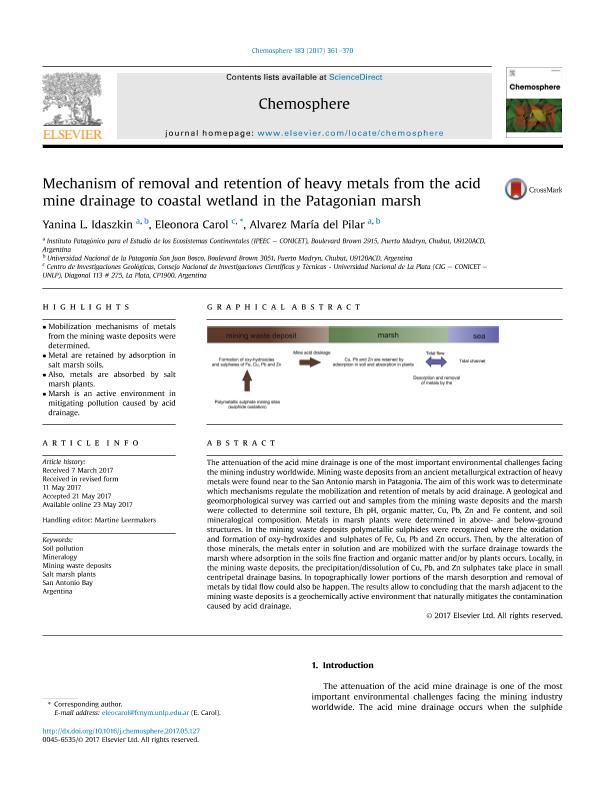Mostrar el registro sencillo del ítem
dc.contributor.author
Idaszkin, Yanina Lorena

dc.contributor.author
Carol, Eleonora Silvina

dc.contributor.author
Alvarez, Maria del Pilar

dc.date.available
2018-10-05T19:08:59Z
dc.date.issued
2017-05
dc.identifier.citation
Idaszkin, Yanina Lorena; Carol, Eleonora Silvina; Alvarez, Maria del Pilar; Mechanism of removal and retention of heavy metals from the acid mine drainage to coastal wetland in the Patagonian marsh; Pergamon-Elsevier Science Ltd; Chemosphere; 183; 5-2017; 361-370
dc.identifier.issn
0045-6535
dc.identifier.uri
http://hdl.handle.net/11336/61807
dc.description.abstract
The attenuation of the acid mine drainage is one of the most important environmental challenges facing the mining industry worldwide. Mining waste deposits from an ancient metallurgical extraction of heavy metals were found near to the San Antonio marsh in Patagonia. The aim of this work was to determinate which mechanisms regulate the mobilization and retention of metals by acid drainage. A geological and geomorphological survey was carried out and samples from the mining waste deposits and the marsh were collected to determine soil texture, Eh pH, organic matter, Cu, Pb, Zn and Fe content, and soil mineralogical composition. Metals in marsh plants were determined in above- and below-ground structures. In the mining waste deposits polymetallic sulphides were recognized where the oxidation and formation of oxy-hydroxides and sulphates of Fe, Cu, Pb and Zn occurs. Then, by the alteration of those minerals, the metals enter in solution and are mobilized with the surface drainage towards the marsh where adsorption in the soils fine fraction and organic matter and/or by plants occurs. Locally, in the mining waste deposits, the precipitation/dissolution of Cu, Pb, and Zn sulphates take place in small centripetal drainage basins. In topographically lower portions of the marsh desorption and removal of metals by tidal flow could also be happen. The results allow to concluding that the marsh adjacent to the mining waste deposits is a geochemically active environment that naturally mitigates the contamination caused by acid drainage.
dc.format
application/pdf
dc.language.iso
eng
dc.publisher
Pergamon-Elsevier Science Ltd

dc.rights
info:eu-repo/semantics/openAccess
dc.rights.uri
https://creativecommons.org/licenses/by-nc-sa/2.5/ar/
dc.subject
Argentina
dc.subject
Mineralogy
dc.subject
Mining Waste Deposits
dc.subject
Salt Marsh Plants
dc.subject
San Antonio Bay
dc.subject
Soil Pollution
dc.subject.classification
Meteorología y Ciencias Atmosféricas

dc.subject.classification
Ciencias de la Tierra y relacionadas con el Medio Ambiente

dc.subject.classification
CIENCIAS NATURALES Y EXACTAS

dc.title
Mechanism of removal and retention of heavy metals from the acid mine drainage to coastal wetland in the Patagonian marsh
dc.type
info:eu-repo/semantics/article
dc.type
info:ar-repo/semantics/artículo
dc.type
info:eu-repo/semantics/publishedVersion
dc.date.updated
2018-05-23T16:35:04Z
dc.journal.volume
183
dc.journal.pagination
361-370
dc.journal.pais
Estados Unidos

dc.journal.ciudad
Nueva York
dc.description.fil
Fil: Idaszkin, Yanina Lorena. Consejo Nacional de Investigaciones Científicas y Técnicas. Centro Científico Tecnológico Conicet - Centro Nacional Patagónico. Instituto Patagónico para el Estudio de los Ecosistemas Continentales; Argentina. Universidad Nacional de la Patagonia. Facultad de Ciencias Naturales. Sede Puerto Madryn; Argentina
dc.description.fil
Fil: Carol, Eleonora Silvina. Consejo Nacional de Investigaciones Científicas y Técnicas. Centro Científico Tecnológico Conicet - La Plata. Centro de Investigaciones Geológicas. Universidad Nacional de La Plata. Facultad de Ciencias Naturales y Museo. Centro de Investigaciones Geológicas; Argentina
dc.description.fil
Fil: Alvarez, Maria del Pilar. Consejo Nacional de Investigaciones Científicas y Técnicas. Centro Científico Tecnológico Conicet - Centro Nacional Patagónico. Instituto Patagónico para el Estudio de los Ecosistemas Continentales; Argentina. Universidad Nacional de la Patagonia. Facultad de Ciencias Naturales. Sede Puerto Madryn; Argentina
dc.journal.title
Chemosphere

dc.relation.alternativeid
info:eu-repo/semantics/altIdentifier/url/http://linkinghub.elsevier.com/retrieve/pii/S0045653517308330
dc.relation.alternativeid
info:eu-repo/semantics/altIdentifier/doi/https://doi.org/10.1016/j.chemosphere.2017.05.127
Archivos asociados
